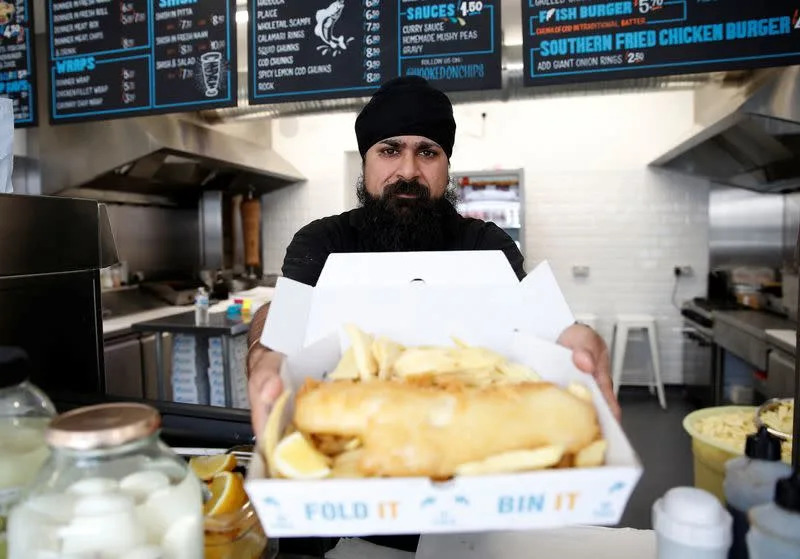Cranking up their bubbling oil friers only to see customers stay at home, Singh and thousands of other normally thriving “chippies” across the island nation are navigating the economic fallout of the Ukraine war, the coronavirus pandemic and Brexit.
“Fish prices have gone up extortionately; oil prices have gone up extortionately; and everything across the whole spectrum that we sell has gone up extortionately,” Singh told Reuters.
Fish and chips in hand, Prime Minister Boris Johnson once promised to “build back batter” from the pandemic.
Now though, rising prices are veering Britain’s economy further off course. A third of fish and chip shops are at risk of going bust this year due to a “perfect storm” of price pressures, according to insolvency firm Company Debt.
In just a year, prices for Britain’s favourite fish – cod and haddock – are up 75%, sunflower oil is up 60%, and flour is up 40%, Company Debt said.
Inflation reached a 40-year peak of 9% in April, the highest in the G7, and is projected to rise further. British consumers are more pessimistic than peers in Europe, leading to criticism of both government and Bank of England efforts to keep a lid on the cost of living.
Cod and chips in Singh’s shop now costs 9.50 pounds, compared to 7.95 pounds a year ago. And Singh said if he passed on all the higher costs, the price would be closer to 11 pounds.
“We’re finding it a struggle to keep our prices reasonable and competitive compared to other fast foods that are in the area, and we’ve actually seen a decline in fish sales and customers walking through the door.”
In the southern seaside town of Swanage, customers said Britain’s inflation problem meant making hard choices.
“It’s alright for me to go in there and get one portion for myself, but that was eleven pounds just for one person,” said Paula Williams, 66, a carer from Weymouth, on a bench outside the Fish Plaice shop.
“When you’ve got a group of five or six, that’s probably more expensive than going to a restaurant.”
RUSSIAN FISH FEEDS BRITAIN
Battered fish and fried chips, the chunky equivalent of fries in the United States, have fuelled Britons since the combination was invented 160 years ago.
The meal is such a staple that unlike other food in Britain, it was not rationed during the world wars. Chippies, with their distinctive smell of oil and vinegar, remain a presence in most towns.
Some of the recent difficulties for fish and chip shops began after Brexit, distant-waters trawler company UK Fisheries said, estimating that the amount of Arctic cod Britain is allowed to catch in 2022 reduced to around 40% of what it was before leaving the European Union.
Russia’s invasion of Ukraine has driven up fuel and electricity prices, further increasing the cost of catching, and frying, fish. The war has sent cooking oil, fertiliser and flour prices higher too.
Cod and haddock are sourced in the Barents Sea, north of Norway and Russia, and the war has heightened uncertainty over those supplies.
In March, the British government listed Russian white fish as among goods to be hit with a 35% tariff as part of sanctions in response to the invasion of Ukraine. It has paused the move, for now, while the impact is investigated.
Sunflower oil is the principle agricultural commodity the UK imports from Ukraine and the government says it is working to substitute it with other vegetable oils: for instance, receiving extra rapeseed shipments from Australia after a strong harvest there.
A spokesperson for Department for Environment, Food & Rural Affairs said it was “working closely with industry, including the National Federation of Fish Friers, to mitigate the challenges that they are facing.”
However, the federation said fish and chip shops were facing their biggest ever crisis.
“I’m getting daily phone calls from people that are worried that they’re going to go out of business,” NFFF President Andrew Crook told Reuters.

‘POOR MAN’S MEAL’
Footfall data from Springboard shows shopper numbers in British high streets are 15% down from 2019, pre-pandemic, levels.
Fish and chip shops are more exposed than some bigger businesses, Yael Selfin, Chief Economist at KPMG UK told Reuters, because they lack buying power to strike a better deals when global prices rise.
“We are expecting consumers and households to reassess what they’re spending on and potentially cut down,” Selfin said.
In his smart, recently refurbished shop in West Drayton, a suburb in Johnson’s own parliamentary constituency, Singh is looking to cut costs and has added cheaper hake and pollock on the menu. But the energy intensive cookers have to stay on.
“If nobody’s coming in, we’re losing money and we need to keep the oil hot,” he said.
In Swanage, builder Malcolm Petherick, 73, worried changes he has seen over his lifetime might result in Britain losing a part of its cultural heritage.
“When I was growing up, it was a poor man’s meal,” he said.
“Now, just bought two lots of fish and chips: 23 quid. What family can afford that?”
from International News Today - Breaking News, US News, World News https://ift.tt/YBgvm01
via IFTTT

